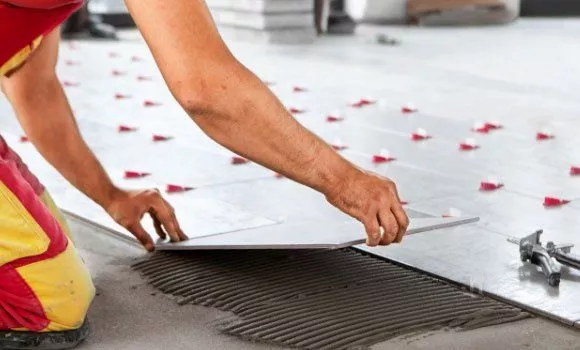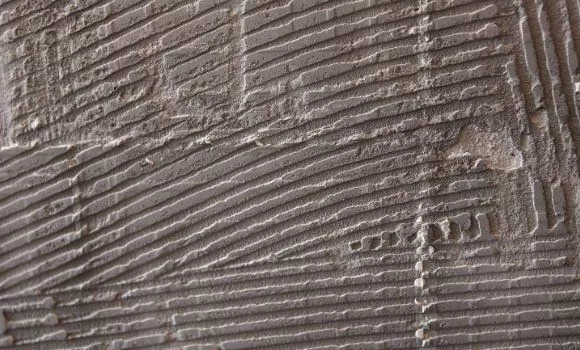
Een decorateur wilde vriendelijk de kosten voor de eigenaar besparen en stelde voor om tegellijm te gebruiken om te mengen met cement om de hoeveelheid materiaal te vergroten. De tegels vielen er echter al snel op grote oppervlakken af! Uiteindelijk hebben de twee partijen een geschil over de aansprakelijkheid voor het verlies.
Na het zien van zulk nieuws, zal de ervaren metselaar hebben gebruld om de domheid van de decorateur:.
Gebruik geen tegellijm om te mengen met cement!
Gebruik geen tegellijm om te mengen met cement!!!
Gebruik geen tegellijm om te mengen met cement!!!
Maar waarom?
Het productieproces bestaat uit vijf delen: de verhouding berekenen, wegen, mengen, verwerken en tegellijm verpakken. Elk van deze processen heeft een belangrijke invloed op de prestaties van lijmproducten.
Het bevat een geschikte hoeveelheid cement, dat wetenschappelijk is samengesteld door toevoeging van verschillende additieven om de hechting en flexibiliteit op basis van cement te verbeteren.
De verhouding van de verschillende ingrediënten in het product is het belangrijkst. Na jaren van experimenteren en oefenen is de tile kleefformule wordt voortdurend verbeterd en het aandeel ervan heeft invloed op het effect van bestrating. Wanneer het bouwpersoneel tegellijm gebruikt, moet hij daarom moet strikt de aanwijzingen op de verpakking volgen, en geen additieven naar believen vermelden.
Vandaag zal ik de misverstanden bij het gebruik van tegellijm op een rijtje zetten. Supervisors, bent u ooit bedrogen?
Misvatting 1: tegellijm is de lijm
Tegellijm, letterlijk gesproken, denken veel mensen dat het cement en lijm is. Het is geen lijm. Het hoofdbestanddeel is cement, dat bestaat uit hoogwaardig cement, gesorteerd kwartszand en verschillende polymeren. Het is een veilig en milieuvriendelijk product dat geen schadelijke stoffen bevat zoals formaldehyde en benzeen.
Misvatting 2: cement en mortel mengen in de tegellijm
Net als in het bovengenoemde geval lijkt het gebruik van tegellijmmengsels met cement de hoeveelheid materiaal te vergroten en de kosten te verlagen, maar in feite veroorzaakt het een aanzienlijk verlies! De reden hiervoor is dat speciale additieven in lijmproducten krachten tussen moleculen kunnen genereren om de tegels stevig vast te kleven. Door cement toe te voegen verandert de productformule, waardoor waardoor de cohesiekracht afneemt en de kwaliteit van het product niet gegarandeerd kan worden.
Misvatting 3: Groot schraapoppervlak voor eenmalig gebruik
In de omgeving van buiten, droog en winderig weer, als het schraapoppervlak van de lijmbatch te groot is, zal de oppervlaktelaag droog zijn voordat de tegel geplakt kan worden, waardoor de tegel eraf zal vallen; Gebruik een getande schraper. om de lijm gelijkmatig over het oppervlak te schrapen, en elke constructie moet binnen ongeveer 1 vierkant. Als het buitenklimaat droog is, moeten de muren van tevoren bevochtigd worden.

Misvatting 4: Lange gebruikstijd, nieuwe lijm toevoegen aan mengsel voor gebruik
Sommige decorateurs mengen het water om tegellijmpoeder te gebruiken met de resterende lijm de dag ervoor in de volgende ochtend. De praktische bestanddelen van de lijm hebben na het mengen een chemische reactie ondergaan en door water toe te voegen veranderen de prestaties, wat in een later stadium resulteert in onvoldoende hechtsterkte; De lijm moet onmiddellijk binnen 2 uur na het mengen worden gebruikt en onmiddellijk na droging worden weggegooid.

Misvatting 5: Tegels direct plakken zonder te egaliseren
Vanwege de lage sterkte van de basislaag en de aanwezigheid van olievlekkenAls de muur niet sterk is, zal het basisoppervlak gemakkelijk delamineren en eraf vallen. Als de wand niet vlak is, is het defect te groot, wat leidt tot een onjuist contact tussen de keramische tegel en de wand, wat leidt tot uitholling. Gebruik daarom niet direct tegellijm met zelfnivellering. Als je dat wel hebt gedaan, moet je leren hoe je holle tegels kunt repareren.
Misvatting 6: Tegellijm gebruiken om de tussenruimte te vullen
Tegellijm en voegmiddel zijn allemaal bouwmaterialen, maar tegellijm kan alleen worden gebruikt om de achterkant van tegels te plakken. Als tegellijm wordt gebruikt om de voegen te vullen, zal het de krimpvoegen van de vloertegels blokkeren, waardoor de vloertegels door de warmte omhoog buigen, wat gemakkelijk hol kan worden en eraf kan vallen. Daarom moet voor het breeuwen speciale tegelmortel of een voegmiddel worden gebruikt.
Gebruik geen tegellijm meer op bovenstaande 6 manieren! Dan hebben we een goede start voor het aanbrengen van tegellijm. Behalve wat we hierboven hebben besproken, is het toepassen van efficiënte en juiste hydroxypropylmethylcellulose (HPMC) voor tegellijm is ook belangrijk. Onze MelaColl™ HPMC-producten bieden de volgende eigenschappen in toepassingen:
- Verbeterde weerstand tegen doorhangen
- Verbeterde verwerkbaarheid
- Verbeterde hechting
- Verbeterde hittebestendigheid en vorst-dooiweerstand
- Verbeterde waterretentie
Voor meer informatie over tegellijmadditieven, zie CONTACT ONS of zoek onze WEBSITE voor uw referentie.


Laat een reactie achter